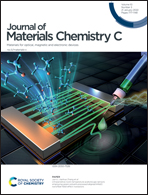Self-healing and stretchable conductor based on embedded liquid metal patterns within imprintable dynamic covalent elastomer†
Abstract
Flexible and stretchable conductors are critical elements for constructing soft electronic systems and have recently attracted tremendous attention. Next generation electronic devices call for self-healing conductors that can mimic the damage repairing ability of natural skins to achieve good reliability and sustainability. Herein, we report a self-healing, robustly conductive, and stretchable conductor enabled by embedding liquid metal (LM) patterns within an imprintable self-healing elastomer. A self-healing poly(dimethylsiloxane)/multiwalled carbon nanotube (PDMS/MWCNT) elastomer was designed by incorporating reversible imine bonds to act as self-healing points and MWCNTs as reinforcement, which featured high stretchability (500%), good elastic recovery and room temperature self-healing ability (94.3% efficiency). Taking advantage of the good imprintability of the self-healing elastomer, a structure confined filling strategy combining nanoimprinting with printing technology was proposed to fabricate embedded LM circuits with a controlled line width in a variety of geometric patterns. The resultant LM embedded structures not only offer a reliable interface to achieve robust conductivity that can resist scraping and peeling, but also provide channels for the fluidic LM to flow and automatically merge together to reestablish conductive pathways. Good healing of mechanical and electrical properties is achieved simultaneously by taking advantage of the dynamic reconstruction of the self-healing substrate and fluidity of the LM. Finally, a fully stretchable and self-healing capacitive strain sensor was demonstrated, showing potential applications in self-healing electronic skin.



 Please wait while we load your content...
Please wait while we load your content...